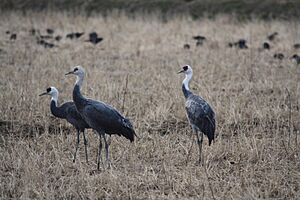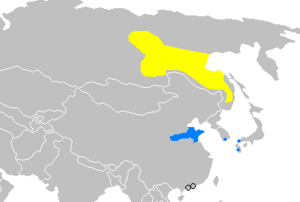Hooded crane facts for kids
Quick facts for kids Hooded crane |
|
|---|---|
 |
|
| Wintering in Kyushu, Japan | |
| Conservation status | |
| Scientific classification | |
| Genus: |
Grus
|
| Species: |
monacha
|
 |
|
| Hooded crane distribution Yellow : breeding range Blue : wintering range |
|
The hooded crane (its scientific name is Grus monacha) is a special type of crane. It lives naturally in East Asia. This bird often travels long distances to Japan for the winter.
Contents
What Does the Hooded Crane Look Like?
The hooded crane has a mostly grey body. Its neck and the top of its head are white. However, there is a small patch of bare red skin above its eye. This makes it easy to spot!
Even though it is one of the smaller cranes, it is still quite a large bird. It can be about 1 m (3.3 ft) tall. It weighs around 3.7 kg (8.2 lb), which is like a small dog. When its wings are spread out, they can reach about 1.87 m (6.1 ft) wide.
Where Do Hooded Cranes Live?
Hooded cranes spend their breeding season in south-central and south-eastern Siberia. Scientists also think they might breed in Mongolia.
Most of these cranes, over 80% of them, fly south for the winter. They gather at a place called Izumi in southern Japan. You can also find them during winter in South Korea and China.
About 100 hooded cranes spend winter each year in Chongming Dongtan, Shanghai. The Dongtan Nature Reserve is the biggest natural winter home for these birds in the world.
Unexpected Journeys
Sometimes, these cranes fly far off their usual path. In December 2011, a hooded crane was seen in southeastern Tennessee, which is in North America! This was very unusual. In February 2012, a similar crane was spotted in southern Indiana. People think it was the same bird. It might have flown to North America by following sandhill cranes.
More recently, in March 2020, seven hooded cranes were seen in Siargao, Philippines. This was the first time this species had been recorded there. Since then, they have been visiting the wetlands in the southern Philippines more often.
How Are Hooded Cranes Protected?
Scientists believe there are about 11,600 hooded cranes left in the world. This number is not very high.
The biggest dangers to these cranes are losing their wetland homes. This happens in China and South Korea. People build new things or dams, which destroys the cranes' wintering grounds.
Good news! People have been working to protect these birds since 2008. Local universities, groups that help nature (NGOs), and communities are all working together. They want to make sure the cranes have safe places to spend the winter.
The hooded crane is listed as a Vulnerable animal by the IUCN Red List. This means it faces a high risk of becoming extinct in the wild. It is also listed on Appendix I and II of CITES. CITES is an international agreement that helps control the trade of endangered animals and plants. A group called Grus monacha International Aid (白头鹤的故事) has even been formed to find ways to protect this special crane.


